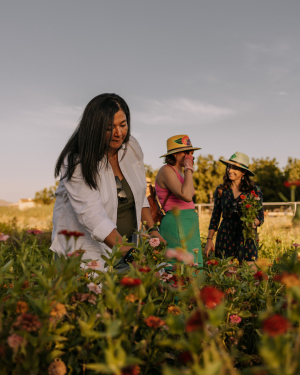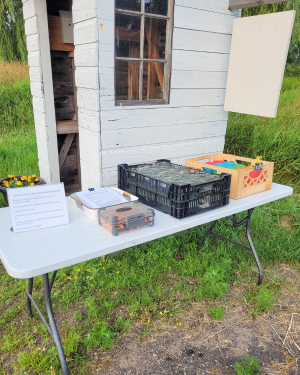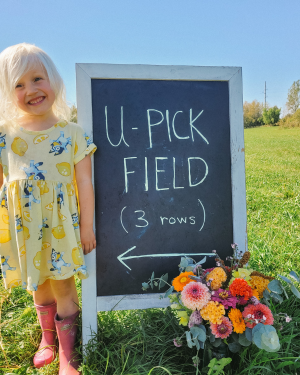- 3 Easy, Reliable, Productive Cut Flowers: Sunflowers, Zinnias & Rudbeckia
- 5 Factors That Determine Vase Life of Cut Flowers
- 2019 American Flowers Week: Combining the Art of Floral Design & Couture
- Celebrate the 7th American Flowers Week | Johnny's 2021 Botanical Couture
- Celebrating the 8th American Flowers Week | Johnny's 2022 Botanical Couture
- Collective Selling Models for Flower Farmers: Flower Hubs That Work
- 5 Cool Flowers to Plant Now | Lisa Mason Ziegler's Secrets for Growing Hardy, Cool-Season Annuals
- Cut-Flower Harvesting & Post-Harvest Care | Best Practices from Pros in the Slow Flower Community
- Cut-Flower Kit | Guide for Market Growers (PDF)
- Easy Cut-Flower Garden Map | For Growers New to Flowers (PDF)
- Easy Cut-Flower Garden Planner | For Growers New to Flowers (PDF)
- From Color to Climate: 5 Floricultural Trends Subtle & Seismic
- Flower Culture by Crop | Comparison Chart | Days to Germination, Weeks to Transplant, Days to Harvest (PDF)
- Flower Farmers' Favorite Fillers & Foliage | Recommendations from 3 Farmer-Florists
- Getting Started in Cut-Flowers | Top 15 Cuts
- Heat & Drought: How Flower Farmers Are Adapting to Changing & Challenging Climatic Conditions
- Introduction to Overwintering Flowers | Guide to Overwintering Flowers
- An Introduction to Producer Marketing Cooperatives | M Lund & Associates
- How Day Length Affects Cut-Flower Production
- Growing Flowers in Hoophouses & High Tunnels: Cool-Weather & Hot-Weather Options
- Growing Flower Seedlings for Profit
- Roadside Flower Stand Basics: Success Tips for On-Farm Retail
- Starting a U-Pick Flower Farm, From A-to-Z
- Year-Round Flower Production Strategy
- Overwinter Flower Trials | Multiyear Results for 30+ Crops | Johnny's Selected Seeds | XLSX
- Seeding Date Calculator | Johnny's Recommended Flowers for Overwintering | XLSX
- Just Add Flowers | An Introduction to Companion Planting for Vegetable & Herb Gardeners
- Pricing & Profitability for Flower-Farmers | Pointers from a Diversity of Pros
- Sustainable Farming Methods | A Survey of Flower Farmers' Best Practices
- Slow Flowers Palette & Petal Crushes | Evolving Colors & Shape-Shifts in Floral Industry Trends
- Johnny's and Slow Flowers | Johnny's Selected Seeds
- Slow Flowers | Celebrating Fifth-Season Regional Design Elements
- Slow Flowers Floral Forecast | A Summary of Industry Insights & Trends
- Building a Better Market Bouquet: Tips, Techniques & Recipes for Flower Farmers
- Slow Flowers | Tips for Staging On-Farm Floral Workshops | Johnny's Selected Seeds
- Wedding Wisdom 101 | 10 Beginner Tips for Entering the Wedding Floral Landscape
- Succession-Planting Flowers | Scheduling & Planning, Sowing Frequency, Recordkeeping & Recommendations
- Succession-Planting Interval Chart for Flowers
- Sustainable Floral Design | Techniques & Mechanics for Foam-Free Floristry | Tobey Nelson & Debra Prinzing
- Video: Mason Jar Bouquet Tutorial
- Video: How to Build a Bouquet
- Video: Tobey Nelson | Sustainable Floral Design | Slow Flowers Summit
- Video: Economic Considerations in Overwintering Cut Flowers | Johnny's Selected Seeds
- Top 10 Cut-Flower Varieties for Direct Seeding
- Video: Floating Row Cover | Baby "Cool Flower" Protection from Whipping Winter Winds
- Video: The Procona System for All-in-one Flower Harvest, Transport & Display
- Johnny's Overwinter Flowers Tunnel: Trellising, Supports, Ground Cover & Spacing
- Video: Irrigation Considerations for the Overwinter Flowers Tunnel | Johnny's Selected Seeds
- Video: Johnny's Overwinter Flowers Trial Recap
- Video: Producer Cooperatives for Small-Scale Farmers | Johnny's Webinar Series
- Climate Adaptation for Vegetable & Flower Farmers | Johnny's Educational Webinar Resources
- Chrysal Classic Professional 2 Transport & Display (Holding) Solution | SDS
- Choosing Flower Crops to Overwinter | Guide to Overwintering Flowers
- Chrysal Clear Universal Flower Conditioner | SDS
- U-Pick Power for Your Flower Farm | Johnny's Webinar Series
- Chrysal Professional 3 Vase Solution Powder | SDS
- Bloom to Boom: Flower Farm Profitability
- Webinar Slide Deck | U-Pick Power for Your Flower Farm | PDF
- Chrysal Professional 1 Hydration Solution | SDS
- Edible Flowers List: Top 20 Favorites from the Slow Flowers Community
- U-Pick Power for Your Flower Farm | Johnny's Webinar Series
- Floral Standards for Flower Farm Collectives and Cooperatives
- Chrysal Professional 2 Transport & Display T-Bag | SDS
- Eat Your Flowers: Serve Up That Wow Factor With Edible Flowers
- Chrysal CVBN Flower Conditioner | SDS
- When to Start Seeds for Overwintered Flowers | Guide to Overwintering Flowers
- Introduction to Forcing Flower Bulbs in Soil | Guide to Forcing Flower Bulbs
- Webinar Slide Deck | Flower Growing in Southern States | PDF
- Forcing Tulip Bulbs | Guide to Forcing Flower Bulbs
- 10 Tips for Building a Profitable Cut-Flower Business
- Chrysal Clear Bulb T-Bag | Cut-Flower Conditioner | SDS
- Video: Flower Growing in Southern States | Johnny's Webinar Series
- Flower Growing in Southern States | Johnny's Educational Webinar Series
- Chrysal Clear Bulb Flower Conditioner | SDS
- Choosing Tulip Varieties for Forcing | Guide to Forcing Flower Bulbs
- Snapdragon Groups Explained
- Flowering in the South: Profiles of 5 flower farmers who cope with temperature, humidity, pest & weed pressure
- Webinar Slide Deck | New-for-2023 Flowers & Floral Supplies | PDF
Starting a U-Pick Flower Farm, From A-to-Z
By Debra Prinzing, Slow Flowers Society, December 2024
If You Open Your Fields to Flower Lovers, They Will Come
Back in June 2011, I traveled with two other garden writers to Pullman, Washington. We had been invited to speak at a specialty plant nursery for its spring opening. I was in search of local blooms and our host sent us off to Sunshine Crafts and Flowers, owned by Jane Stratton. The hand-painted sign on Old Moscow Road welcomed us: U-Pick Flowers. It was a thrilling experience to arrive, to meet Jane, and to spend time walking between the garden and rows as we clipped stems of bachelor’s button, lupine, columbine, poppy, snowball viburnum, lilac, and more. I snapped a lot of photos, a date-stamp of the time when I was writing my book, Slow Flowers. Its pages include a vase arrangement with some of Jane’s flowers from that visit—you can see it on page 40. When Johnny’s asked me to gather the best ideas and pro tips for flower farm U-Pick programs, I went back to find my photos and read my blog post about that outing. The joy we felt at Jane’s U-Pick farm feel just as real today. Discovering fields of flowers—ready for cutting—prompts excitement, no matter where you are.
I reached out to five expert growers to learn more about their U-Pick programs and discovered that there’s a lot to know as you evaluate the pros and cons. I learned volumes from Susannah Calhoun, of Calhoun Flower Farms in Las Cruces, New Mexico; Randi Greiner of Beezie’s Blooms in Milaca, Minnesota; Chelsea Willis of Sweet Delilah Farm in Portland, Oregon; Melanie Harrington of Dahlia May Flower Farm in Trenton, Ontario, Canada; and Sarah Daken of Grateful Gardeners in Poolesville, Maryland.
Follow along to learn the best practices you’ll want to consider for your own U-Pick operation. Then, take Sarah Daken’s advice and know that policies can always be adjusted or adapted. As a lawyer in her prior career, she laughingly admits to asking herself, "'What are the things that will happen—worse case—and how do we figure out how to ameliorate those things?' Just be aware that it’s easier to set a boundary and loosen it than it is to not have one and then try to impose it!”
When and How: Making a Plan

U-pick bouquets at Dahlia May Flower Farm. The farm hosts about 20 u-pick events each summer, selling tickets much like a workshop.
Image © Melanie Harrington
Unless you find yourself with excess production and need to convert unsold flowers into instant revenue, it’s good to start with a plan, say the flower farmers. The "plan" should begin with listing reasons to open up your farm to U-Pick events. Because so many flower farmers also live on their farm, this is an important consideration—for family privacy, liability and potential damage to crops, and many other reasons. Each of the growers with whom I spoke say that it’s important to set policies from the start, including when you open the gates and where the guest experience occurs on your farm.
Timing (the “when”) has a lot to do with the crop selection. In Chelsea Willis’s case, she inherited a lavender U-Pick business that had been in operation for 14 years before she purchased the farm, located on Portland’s Sauvie Island. “I kept some of that lavender because I knew that people wanted to come for U-Pick,” she explains.
There are growers who plan for summer U-Picks and others who view it as an end-of-season option after other sales channels wrap up (such as weddings). It's the farmers’ prerogative to design a U-Pick program to suit your lifestyle, says Melanie Harrington of Dahlia May Flower Farm. She sets and posts a schedule of about 20 events during the summer months (usually on Friday evenings), selling tickets much like a workshop. “It is a class that runs from 6 to 8 p.m. It’s not a drop-in experience,” she says. “We ask folks to come 15 minutes ahead of time so we can check them off of our list, get them settled, and show them where the fields are.”
With three small children, Randi Greiner of Beezie’s Blooms decided to set up her U-Pick as a self-serve option, open from sunup to sundown, seven days a week. “Last year we allowed people to come on Fridays and Saturdays, but I realized that was too limited. This year, we set it up so people could come every day, and it was just a lot easier,” she says. The farm is well situated on a highway traveled by vacationers, enabling Beezie’s Blooms to capture weekend customers, while parent-child outings and community groups often come during weekdays.
Sarah Daken and Tom Precht of Grateful Gardeners have found it best to schedule several 2-hour U-Pick slots in a given day—each with a specific start and end time —to ensure that customers arrive on time, ready for the fun. They limit the number of U-Pick tickets to 40 per time slot, which also helps with crowd control and parking flow.
At Calhoun Flower Farms, Susannah Calhoun has experimented with a number of U-Pick options over the past seven years, but most recently, she scheduled four events per month—the first and third Thursday evenings and Saturday mornings, spring to fall. She observes that the varied time slots attract different customer demographics.
All of the growers see the benefit of curating private events around U-Pick, including yoga classes, design workshops, and wedding parties. These higher-value events are custom tailored and custom priced to accommodate the farmer’s time, the cost of flowers, and any add-on experience, such as an instructor’s time.
Crop Planning and Selection
Some of the most important planning revolves around planting specific flower beds, rows or fields for U-Pick use. “I keep it really simple (and cheap) with summer annuals,” Melanie says. “Sunflowers, zinnias, amaranth, marigolds, and celosia are the bread and butter of it. If I want to get fancy, I’ll plant ‘White Lite’ sunflowers!” While she doesn’t specifically plant foliage crops for U-Pick, Melanie tells guests they can forage from her hedgerows for grasses or greenery. “I’ve caught them harvesting actual weeds for their vases,” she laughs.
When Grateful Gardeners first offered U-Pick, it was at the urging of Ellen Seagraves, a florist client, who asked them, “have you ever thought about having people out here?” After Sarah and Tom expressed hesitation, Ellen continued: “What if you just did it at the very end of the season?”
The conversation inspired Grateful Gardeners to host a U-Pick dahlia event in 2023. “That was the best day we had on our farm the entire season,” Sarah recalls. “I’ve never seen so many smiles and so much joy. It’s what we needed to experience in order to try it again.”
When planning for 2024, they planted twelve 100-foot rows of annuals, including zinnias and celosia. “Even though we established the area for U-Pick only, we had so many cut-and-come-again varieties that those rows also became a revenue source for our farmers’ market, too,” Sarah says. The addition of annuals allowed Grateful Gardeners to offer two crop options (priced differently), with annual U-Pick events in June, July, and August, followed by four dahlia U-Picks in September.
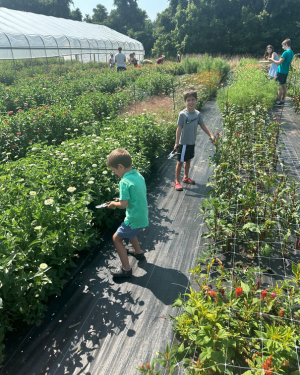
U-pick fields at Grateful Gardeners. Wide and smooth footpaths help ensure easy access for would-be pickers of all sizes.
Image © Grateful Gardeners.
Beezie’s Blooms devotes three 100-foot rows for its U-Pick program, also planted with cut-and-come-again annuals. “I initially plant about two-thirds of each row at the beginning of the season, and then I leave a gap for some fresh plantings, so we can keep the fields open later in the summer,” Randi notes.
Susannah likes single-variety U-Picks, allowing her to plant and program for specific crops, including marigolds and sunflowers. Calhoun Flower Farms also maintains a few acres of lavender for their U-Pick events.
At Sweet Delilah Farm, in addition to the lavender program, “I like to offer U-Pick at the end of the season when I’ve done all my other events,” Chelsea says. “That way, I can just let people pick in certain sections, like the zinnia and marigold rows. I also let them cut in my dahlia fields, except for the areas set aside for dahlia breeding.”
Because her farm is more workshop- and event-oriented, rather than focused on high-volume production, Chelsea says she’s been able to experiment with themed U-Pick events. “After eight seasons, I’ve found having an event niche more enjoyable,” she says. “For example, I’ll offer sunset yoga, followed by access to U-Pick. I get inquiries from bridal parties who want to pick flowers for their bouquets, so I offer that as a private event and in conjunction, I’ll cut their roses for them. We also have a U-Pick dye plant event, so people pick their flowers and then dye bandanas.”
Pricing and Ticketing
Of the group of five growers I interviewed, there is a wide range of ticketing and pricing options, from Self-Serve to Reserved, Pre-Purchased slots. Each has its benefits and each is structured to fit the needs of the farmer’s time. Some sell tickets on platforms like Eventbrite; many use their existing e-commerce platforms, such as Square Space, or use on-site payment options such as QR codes or even a cash box.
At Beezie’s Blooms, customers arrive at the U-Pick check-in stand where they scan a QR code to pay $30 for adults and $10 for children. There is a laminated information sheet for them to review and crates filled with Mason jars for adults and small paper cups for children, plus a bin with clippers. In the past, Randi has also used a cash box for U-Pick payments, but since the check-in station isn’t staffed, she dropped that option. She also books private group U-pick experiences and offers “Flower Fridays” after-hours events for a higher per-person ticket price.
At Dahlia May Flower Farm, U-Pick guests must pre-pay for their $50 ticket on a specific date, which Melanie likens to a concert ticket, meaning, no “plus ones.” “One ticket is for one person is for one bouquet,” she notes. “We limit our experience to 25 tickets for two hours. It takes two staff members to run the event—myself and one assistant. If there are 25 people who each bring their mom or husband or girlfriend—even if they are just here for the experience and don’t intend to cut flowers—we all of a sudden have to manage 50 people.” Once she explains the “concert” analogy to customers, they usually understand. The $50 ticket includes two hours to pick flowers, plus a glass vase for arranging their blooms.
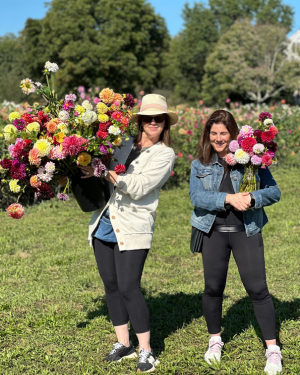
Grateful Gardeners offers customers a $50 vase and a $150 floral bucket option.
Image © Grateful Gardeners.
For its dahlia U-Picks, Grateful Gardeners offers customers a $50 vase and a $150 floral bucket option, which must be pre-purchased through the farm’s online shop (the annual U-Pick events are lower priced). “Most people buy the vase option, but when they get here, they decide to switch to a bucket,” Sarah observes. She marvels at the quantity of stems guests are able to cram into a container, regardless of its size. “I try to base the price on what would be a reasonable amount of stems to fit in the cylinder vase or bucket, and how much would that generally cost.” She estimates that some overeager guests walk away with $500 worth of dahlias for their $150 bucket fee. “But if we didn’t open up our farm to people, that revenue wouldn’t be here,” Sarah points out.
Sweet Delilah Farm customers pre-purchase U-Pick tickets for $15, which is good for a small handful of lavender or flower stems. They are required to bring their own clippers and a container with water for transporting flowers home. Chelsea offers eco-fresh wraps for people who forget a container. “I want to keep it really accessible. We’ve had a good turnout with this pricing and most people end up buying more stems, like dinner plate dahlias. I always sell other items, like T-shirts, and seeds, so it’s like a soft up-sell.” Any related class or workshop has a separate fee and the $15 U-Pick is treated as an add-on cost.
At Calhoun Flower Farms, Susannah has experimented with a number of options over the years. U-Pick sessions and other events that include U-Pick range from 20 to 350 guests, and tickets must be pre-purchased. Instead of a Mason jar, Calhoun Flower Farms U-Pick customers gather their stems in a southwest-style clay jar called a “Cantarito.” Depending on the jar size, customers pay between $20 to $45 for their U-Pick session. There is also a $65 full bucket option for DIY customers. The farm is planning to market 50 “flower pass” tickets, which will allow customers to attend all of the scheduled U-Pick events in 2025. “It will help us generate some funding in the winter,” Susannah explains. “I’m thinking of creating a brass or copper bangle bracelet that is personalized for each buyer.”
Safety and Liability
Ensuring that you, your farm and staff, and your guests are safe is a top recommendation from those I interviewed. “Make sure that you’ve got the right insurance,” Chelsea points out. “Every year, I have a conversation with my insurance person who asks, ‘how have things changed?’” Similar to homeowners policies, a farm can add event-specific coverage to an existing policy, she adds.
You should also check local zoning regulations for on-farm events, Susannah suggests. She learned from her insurance agent that it’s best to schedule U-Pick sessions as private events. “People have to pre-book to come here and experience our flowers. We’re never open to the public; we don’t publicize hours,” she explains. Hosting U-Pick as a private event also factors into other items on her checklist, such as designing parking areas that comply with local zoning rules. “We have a licensed commercial driveway at Calhoun Flower Farms, but we would have to have so many other registrations and certifications in order to hold public events,” Susannah notes. “Guests are sent a YouTube video when they purchase their ticket, so they know how to harvest when they get here. We’ll go over the rules again when they arrive. I try and make it funny. I ask them how many fingers they have and how many fingers they’ll have when they leave. No one can come onto the farm without checking a box that says, ‘have you read the waiver?’”
Sarah says her “biggest nightmare” revolves around children. She allows guests to bring their children but does not allow anyone under 10 to cut flowers. Registration details state that U-Pick is not appropriate for children under 4 years old, and that the ground is not stable for people using walkers.
“When people arrive, they aren’t allowed to go to our field until they sign our liability waiver,” Sarah notes. “The form says that we are not held responsible for accidents on the property. Yes, we have insurance, but I want customers to remember that there is some inherent risk they assume when coming to a farm setting.” The waiver also gives a guest’s permission for Grateful Gardeners to use their likeness in any promotional materials, making it easy for Sarah to take and post photos of U-Pick experiences.
Dahlia May Flower Farm maintains a $2 million (CDN) liability policy. “When I see people asking questions about insurance in farming forums, my tip is to start with the company where you already have home or business insurance—and add extra insurance for U-Pick events,” Melanie says. Her other hot topic is to add as much programming structure as possible: “Take nothing for granted, because people are people. So lay things out in your ticket information—no pets, no smoking, no drinking, one ticket per participant.”
Good directional signage at the parking area and in the U-Pick fields help minimize other problems. At Grateful Gardeners, for example, Sarah and Tom attach brightly-colored flagging tape to the top of T-posts and dahlia cages to avoid potential injuries.
You can also tailor U-Pick events to make them safe for families. At Sweet Delilah Farm, Chelsea has a basket of plastic, kid-friendly scissors for younger guests’ use. Grateful Gardeners has added “Mommy and Me” midweek dates for parents and young children, while Beezie’s Blooms similarly hosts home school groups at designated times.
People Management
I’ve already touched on the importance of creating policies for managing your U-Pick event—with or without pets and children. If you want guests to bring their own clippers, wear a hat and comfortable shoes, and bring a water bottle—tell them up front and often.
And that leads us to restroom facilities. Most of the farms I interviewed rent a portable restroom for their farming season. It can be used by crew members, people who come for tours or workshops, and U-Picks. “We spend about $200 per month,” Sarah says. “And I don’t want anyone from the public coming into our house, so it’s money well spent!” Chelsea at Sweet Delilah makes it clear that her farm does not have restroom facilities, but she admits there’s always one person who asks to use her facilities.
Beezie’s Blooms requires professional photographers to book a separate time to use flower fields for photo sessions, which means U-Pick customers are not allowed to bring along their own professional photographer.
Communications, Social Media, and Community Building
It’s important to leverage your U-Pick events to raise awareness about locally-grown flowers for your community. Most farms I spoke with collect email addresses throughout the season and then use that list for sending invitations, email blasts, and newsletters to promote their U-Pick schedule and other on-farm events. Having a social media is a plus. A field of flowers is an irresistible selling point—this is a visual and sensory business, after all, so play to your strength. Offer to take guests’ photos of their U-Pick experience at “the golden hour,” and they’ll be sure to post them—and tag you. Melanie takes videos during U-Pick events and then posts the “behind the scenes” footage to tease upcoming dates. “Showing the activity on Instagram stories is really effective for us because it looks so fun—and then I remind followers that there’s another U-Pick coming up tomorrow night or next week.”
Know Your Why
Hosting a U-Pick program brings both psychic benefits and financial ones—such as a jolt of cashflow just when you need it. For Randi at Beezie’s Blooms, the program not only allows her to farm at home with her youngsters, she and her husband have decided to donate 100 percent of their U-Pick revenue to Operation Underground Railroad, a nonprofit organization that fights child sex trafficking. They make sure customers know their patronage helps this cause.
For others, U-Pick provides an income source and a way to satisfy all those requests from fans who want to visit. “The best part of U-Pick is hearing the conversations between guests,” Sarah says. “These days are reminders of how much joy flowers bring to people. It’s very soul-fulfilling for us during a season when we’re totally exhausted. It recharges our batteries, for sure.”
“I love the educational piece and seeing people come here to experience flowers in all their different forms,” Chelsea says. “I have found a lot of joy as I just sit and listen to people getting excited about a new flower they see or discovering our frogs everywhere. We have a swing set on the farm, so it’s fun to see kids and grandparents on the swings together.”
In terms of gross revenue, Dahlia May Flower Farm brings in $25,000 from its U-Pick program in a typical season. “So many guests who came this summer were people who came last summer, loved the experience, and wanted to do it again,” Melanie points out. “It really is a repeat experience.”
Adds Susannah: “Ten years ago, it was a lot harder to convince people to pay a fair price for local flowers. But now, we’re creating a social bridge between people and agriculture. Just like buying local produce, when people experience our flowers, they’re beginning to appreciate the value of what we grow.”
Learn More
- 3 Easy, Reliable, Productive Cut Flowers • Our Recommended Short-List • Article
- Getting Started in Cut-Flowers • Top 15 Tier-1 Cuts • Article
- Succession Planting • Interval Chart for Flowers • CHART
- Succession Planting • Recommended Flowers • Table
- Top-10 Flowers for Direct-Seeding • Charticle
- Easy Cut-Flower Garden for Home Gardeners • Planner & Growing Guide • PDF
- Easy Cut-Flower Garden for Home Gardeners • MAP • PDF
- Cut-Flower Kit for Market Growers • Growing Guide • PDF





